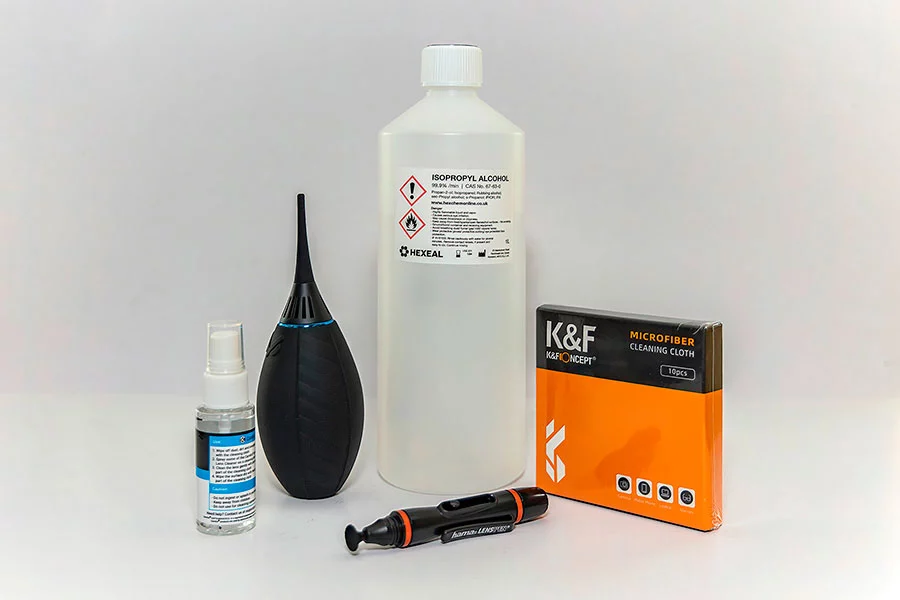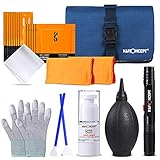DIY Video Studio is supported by its readers who use the affiliate links or ads on this site. As an Amazon Associate, I earn from qualifying purchases. Thank your support if you use any of the links.
Although there are a number of camera lens cleaning products you could use, alcohol is the best and easiest alternative for a smudged or dirty camera lens when you don’t have any products on hand. Of course, this doesn’t mean you can use any type of alcohol, and when cleaning a camera lens with this product, you’ll want to take extra care to do it properly, or you could cause irreversible damage.
In this article, we’ll take you step-by-step through the process of safely cleaning your camera lens with alcohol. We’ll describe what type of alcohol you’ll need, what other materials are necessary for this guide, and you’ll learn the basic dos and don’ts of camera lens cleaning.
Gather Your Materials
As you might have guessed, the first step of cleaning your camera lens with alcohol is to have the proper tools and materials ready to go for a quick and easy process.
In order to clean a camera lens with alcohol, you will need:
- 99% Isopropyl alcohol
- Q-tip cotton swabs or lens pen
- A microfiber lens cleaning cloth
- A soft-bristled lens cleaning brush
And that’s it! Pretty simple, and most of these tools you can find in any ordinary bathroom, or they might even come with your camera or camera lens when you first receive it as part of a complimentary cleaning kit.
You’ll want to make sure you have these soft tools, like the cotton swabs, microfiber cloths, and soft-bristled brush, because they’ll ensure you don’t accidentally scrape the delicate surface of the lens while cleaning like you would with a more abrasive brush or textured cloth.
Does it Have to Be 99% Isopropyl Alcohol?
Isopropyl alcohol can be purchased in a wide range of percentages, so it is understandable that if you have 70% isopropyl alcohol at home, you’d question if you really need to go out and buy 99%.
The answer to this question is a bit subjective. It is highly recommended that you purchase 99% isopropyl alcohol for your lens cleaning, as it is a more concentrated solution and will therefore be more effective at cleaning and less likely to leave a sticky residue that could damage or obscure your lens (effectively defeating the purpose of cleaning it).
- [Professional Lens Cleaning Kit] : Dslr cleaning kit includes Lens Cleaning Pen + Camera Air...
- [Sensor Cleaning Swabs] : Microfiber lens sensor cleaning Swabs are packed individually in...
- [Air Blower + Anti-static Gloves] : The camera air blower will direct a stream of air to blow away...
- [15ml Cleaning Liquid + Re-usable Spray Bottle] : Ammonia Free, Toxic Free, and has low VOC. Safe...
Last update on 2025-10-20 / Affiliate links / Images from Amazon Product Advertising API
Brush off Your Lens with a Soft-Bristled Brush
Once you have all of your cleaning supplies ready, you can remove your lens from your camera and get started cleaning. However, before you jump into wiping it down with your isopropyl alcohol, you need safely remove any excess dirt or debris on the lens surface.
It is important that you brush your camera lens with a soft-bristled brush before cleaning it with any products, especially alcohol. Skipping this step means you might wipe the dirt, sand, and other gritty materials into the glass or plastic covering of your lens, resulting in scratches or other types of damage.
This is probably the most commonly skipped step when cleaning a camera lens and could consequently cost you your lens’s integrity. If you don’t have a soft-bristled lens cleaning brush lying around, your extra Q-tips will work in a pinch.
If you have an air blower tool that comes in typical camera cleaning kits, this would be a good time to break it out to remove larger loose particles of dirt and dust. If left on the lens surface these may act as an abrasive when you come to clean the lens.
Refrain from resorting to other DIY methods for removing surface dirt and debris, such as using your breath to blow on the lens, as your breath and saliva create condensation on the surface filled with harmful acids that will degrade the lens’s coating.
Create a 50/50 Mixture with Your Isopropyl Alcohol
Photographers around the world debate this next step, but we believe the safest thing for your camera lens when cleaning it is to create a diluted mixture rather than opting for the full power of the isopropyl alcohol.
While you can clean your camera lens solely with 99% isopropyl alcohol, this product alone can be a bit strong for most camera lenses and potentially degrade the lens coatings if used on its own. Therefore, we recommend you create a diluted mixture of 50% water and 50% alcohol.
It might seem inherently wrong to place even a drop of water on your camera lens, but we assure you this will be harmless, especially when mixed with the isopropyl alcohol.
Since there are no electrical elements in the camera lens itself, cleaning it with this diluted mixture won’t risk any electrical damage if you keep it contained to the lens alone. The real risk with water, or any liquid for that matter, is how long you leave it on the lens. The longer you let this mixture sit and dry on your camera lens, the greater your odds of leaving spots, streaks, and causing damage.
So, as long as you move quickly in this guide, you shouldn’t have to worry about using a water/alcohol solution.
Furthermore, if you live in a soft water area, dissolved minerals in tap water may be left on the lens surface if the water is allowed to dry through evaporation.
Use Your Diluted Alcohol Cleaning Solution to Wipe Down the Camera Lens
Now we can use our new and improved cleaning solution to wipe away all of those pesky smudges and films that are ruining what would otherwise be perfect photos.
Apply 3-5 drops of your diluted alcohol cleaning solution to a corner of your microfiber cloth and gently rub the solution into your camera lens. If you are using a spray bottle instead, spray a very small amount of the solution only on the cleaning cloth.
If you don’t have a microfiber lens cloth, you could use lens tissues or Q-Tips as alternatives. An even better alternative is a lens pen. This has a soft bristle brush at one end and a circular or triangular cleaning pad at the other. You’ll want to use very minimal amounts of liquid to protect the integrity of your camera lens and its cover. A little will go a long way here.
DO NOT apply isopropyl alcohol or cleaning fluid directly on to the surface of a lens. Always apply the fluid on to a microfiber cloth, Q-Tip swab, etc.
Immediately Dry the Lens Using a Microfiber Lens Cloth
Once you’re certain all dust, debris, smudges, and other obstructions are cleaned from your camera lens, you’ll want to quickly remove any liquid left behind.
Dry the camera lens completely using the dry portion of your microfiber cloth. You’ll want to do this immediately after wiping it clean with the alcohol solution since, as we mentioned previously, time is of the essence if you want to clean your lens as safely as possible. Afterward, you can either decide to stop here, or you can proceed to the other side of your camera lens and use your Q-tips to clean the rear elements of your lens as well. You can do this by following the same steps you just followed to clean the other side of the lens.
Camera lens cleaning FAQ
Why is Isopropyl alcohol used for lens cleaning?
Because Isopropyl alcohol mixes with water and dissolves many oils, greases, gums, and resins it is used widely as a solvent and cleaning fluid. It also evaporates quickly, leaving almost no oil traces, and is relatively non-toxic. Therefore, it is commonly used for cleaning eyeglasses and lenses.
Can I use Windex to clean my camera lens?
Windex should not be used to clean a lens or camera. The ingredients of Windex include coloring and foaming agents, fragrance, and a form of ammonia, as well as other chemicals. These may damage lens coatings and therefore degrade lens performance. Windex also gives off ammonia fumes, which might irritate your throat and eyes.
How do you clean old camera lenses?
Microfiber cloths and cotton buds moistened with a few drops of lens cleaning solution work. But if dirt particles are on the lens surface, dislodge them with an air blower or lens brush. A lens pen is also invaluable, the small circular or triangular pad can clean right to the edge of the lens.
Does a dirty lens affect the image quality of a photo?
A dirty lens will affect the image quality of your photos. Try and avoid getting dust, finger marks, and smudges on the lens, and clean off any that are apparent with a microfiber cloth. On a smartphone, a simple wipe should be enough, but with an SLR camera lens more care is required since you could damage the lens surface and coatings.
Do all lenses have dust in them, and should I worry about dust in a lens?
A little dust in a lens is not uncommon. If the internal volume of the lens changes while focusing or zooming, air will be drawn in or expelled. This flow of air may allow dust to enter. A small amount of dust is OK. But a lot of dust on the lens surface will reduce contrast and affect image quality.
Tosh Lubek runs an audio and video production business in the UK and has been using the Canon EOS R since it was released in the Autumn of 2018 and the Canon EOS R6 in 2020. He has used both cameras to shoot TV commercials broadcast on Sky TV, promotional business videos, videos of events and functions, and YouTube creator content. He has also won several international awards for his advertising and promotional work. You can meet him by visiting his “video booth” at HashTag Business Events across the country.
Recent Posts
Most people use sandbags the wrong way. Here’s how to hang them properly on a light stand for maximum stability and safety — plus what to fill them with.
You're Using the Canon RF 50mm f/1.8 WRONG! Here’s How to Fix It
If you’ve recently picked up the Canon RF 50mm f/1.8 STM—affectionately known as the Nifty Fifty—you might be confused by that strange switch on the side of the lens. It doesn’t say AF/MF...



